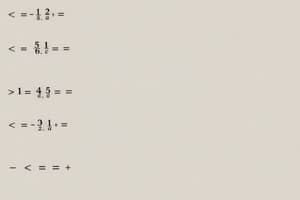Podcast
Questions and Answers
What is the primary purpose of simplifying a fraction?
What is the primary purpose of simplifying a fraction?
- To reduce the fraction to its simplest form (correct)
- To compare fractions with different denominators
- To find the equivalent fraction
- To add or subtract fractions with different denominators
What operation is required to compare two fractions with different denominators?
What operation is required to compare two fractions with different denominators?
- Subtraction
- Addition
- Multiplication
- Finding the least common multiple (LCM) (correct)
What is the result of multiplying 2/3 and 3/4?
What is the result of multiplying 2/3 and 3/4?
- 1/4
- 1/2
- 1/6 (correct)
- 5/6
What is the definition of an equivalent fraction?
What is the definition of an equivalent fraction?
How do you divide a fraction by another fraction?
How do you divide a fraction by another fraction?
What is an example of a real-world application of fractions?
What is an example of a real-world application of fractions?
What is the greatest common divisor (GCD) of 6 and 8?
What is the greatest common divisor (GCD) of 6 and 8?
Flashcards are hidden until you start studying
Study Notes
Fractions
Definition
- A fraction is a way to represent a part of a whole
- It consists of a numerator (top number) and a denominator (bottom number)
Key Concepts
- Equivalent Fractions: fractions that have the same value, but different numerators and denominators
- Example: 1/2 = 2/4 = 3/6
- Simplifying Fractions: reducing a fraction to its simplest form by dividing both numerator and denominator by their greatest common divisor (GCD)
- Example: 6/8 = 3/4 (GCD of 6 and 8 is 2)
- Comparing Fractions: determining which fraction is larger or smaller
- Example: 1/4 < 1/2 (1/4 is less than 1/2)
Operations with Fractions
- Addition and Subtraction: add or subtract fractions with the same denominator
- Example: 1/4 + 1/4 = 2/4
- Multiplication: multiply the numerators and denominators separately
- Example: 1/2 × 3/4 = 3/8
- Division: invert and multiply (i.e., flip the second fraction and multiply)
- Example: 1/2 ÷ 3/4 = 1/2 × 4/3 = 2/3
Real-World Applications
- Measuring ingredients for a recipe
- Dividing a pizza among friends
- Comparing ratios of different quantities
Fractions
- Represent a part of a whole, consisting of a numerator (top number) and a denominator (bottom number)
Equivalent Fractions
- Fractions with the same value but different numerators and denominators
- Example: 1/2 = 2/4 = 3/6
Simplifying Fractions
- Reducing a fraction to its simplest form by dividing both numerator and denominator by their greatest common divisor (GCD)
- Example: 6/8 = 3/4 (GCD of 6 and 8 is 2)
Comparing Fractions
- Determining which fraction is larger or smaller
- Example: 1/4 < 1/2 (1/4 is less than 1/2)
Operations with Fractions
Addition and Subtraction
- Add or subtract fractions with the same denominator
- Example: 1/4 + 1/4 = 2/4
Multiplication
- Multiply the numerators and denominators separately
- Example: 1/2 × 3/4 = 3/8
Division
- Invert and multiply (i.e., flip the second fraction and multiply)
- Example: 1/2 ÷ 3/4 = 1/2 × 4/3 = 2/3
Real-World Applications
- Measuring ingredients for a recipe
- Dividing a pizza among friends
- Comparing ratios of different quantities
Studying That Suits You
Use AI to generate personalized quizzes and flashcards to suit your learning preferences.




